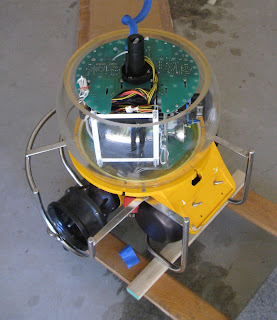The ROV (Remotely Operated Vehicle) recommissioning project actually began back in June 2011, but, as the excuse always goes, we were too busy pushing the project towards completion to document much beyond technical and procedural info and a few photos.
At length - and this has become one of the major educational elements of the whole endeavor - we found that the project was going to take much longer than we'd originally anticipated. In order to actually get it done, I set up a directed study elective at school that allows me two periods a week to dedicate to the recommissioning project - first, restoring seaworthiness, and later, implementing some cool inertial navigation features.
My directed study advisor, the Dr. Kellogg, put forward one very practical condition for adding the ROV project to my courseload: that I blog the whole thing, making
this page a second lab book that he and any other geeks out there can look at.
Prior to reading further, I suggest you pop over
here for a couple minutes if you're unfamiliar with what an ROV is.
Last but not least before jumping into nuts and bolts, I'll explain
why we're doing this.
The
Ty Warner Sea Center is a unique facility in that it not only features the tank exhibits customary to public aquariums, but also takes advantage of its wharf location with a wet deck, or "center well," as they're called on research vessels. This is basically a big square hole in the floor of the Sea Center that goes clear through the wharf decking to open on thirteen to twenty feet of ocean below. Currently, we lower simple equipment through it to capture plankton and crabs, test water clarity, and sample water and sediment.
 |
| Ty Warner Sea Center in Santa Barbara, Wet Deck circled in red. Image: trekaroo.com. |
While working with this gear affords visitors a piece-by-piece look at the ever-changing kelp forest ecosystem, an operational ROV offers virtual immersion in the marine environment, not to mention the excitement of launching and piloting high-tech equipment.
Now that you know what we're about here, some cold, salty facts:
We're recommissioning an Offshore Hyball ROV owned by the Santa Barbara Museum of Natural History Ty Warner Sea Center. The Offshore Hyball was produced by Hydrovision, Ltd. in Scotland from the mid '90s until the company was bought by
SMD in 2001. (
ref)
 |
| "Before" photo in the shop: She's pretty salty from sitting in the wet deck room for some four years. |
Of course, matters are never that simple. Our unit appears to be one-of-a-kind, and was prepared specifically at some point for static display and use as an oversized sitting-duck-type "drop cam." Two things in particular have led us to believe that this work was done at Hydrovision's Aberdeen shops: first, the serial label (below), and second,
 |
| Note designation as "Dummy" Offshore ROV |
the fact that an SMD service engineer found this SN classified as a "drop camera" in the old Hydrovision database.
Consequently, while our unit has the wider viewport, hydrodynamic transformer housings, and green decals (photos to follow) characteristic of the Offshore Hyball, its yellow fiberglass-composite hulls and aluminum thruster bodies are from the older "Standard" Hyball model.
Numbers types: please see spec pages for the
Standard and
Offshore Hyballs if you wish to compare.
The moral of the technical story so far? We're working with a lot of spare parts.
Nonetheless, Hydrovision's designation of the unit as a "drop cam," along with what we found on initial inspection of the system, indicated basic seaworthiness. Though the thruster motors and their electronics were gone, and the O-rings needed swapping, most of the mechanical components were still good, not to mention rated to three hundred meters ocean depth. Thus, with mostly off-the-shelf components, we set off to resurrect what was originally a $30,000+ tool at a comparatively modest cost. At present we believe we're within a month of a confined-water launch.
Much more shop talk on our trials, triumphs, and progress to follow. Enjoy!
><(((˚> Jacob
































